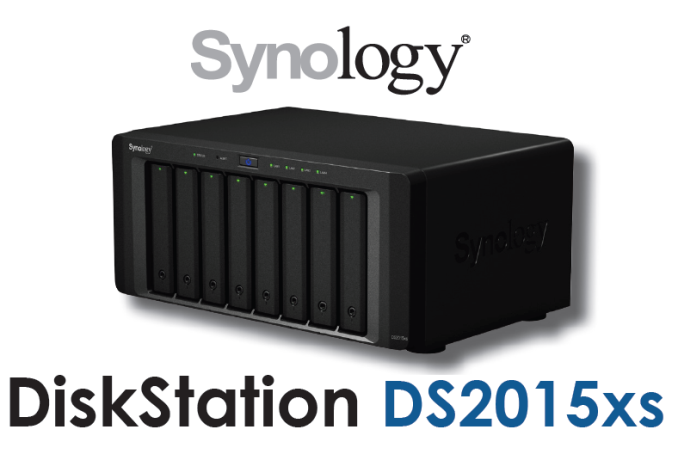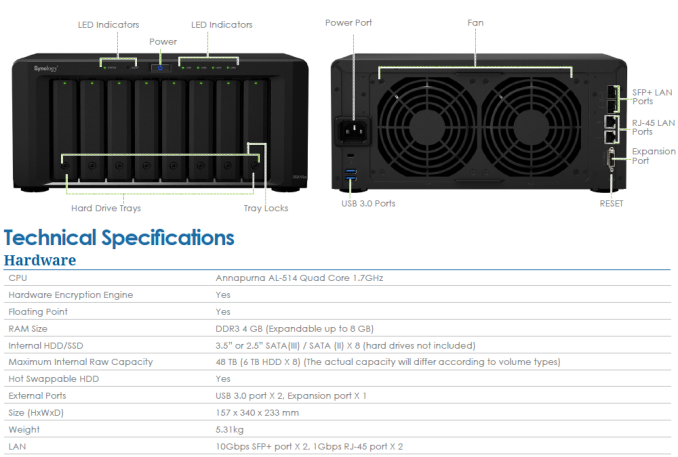Synology's DS2015xs brings ARM to High-Performance NAS Units
by Ganesh T S on December 9, 2014 3:00 AM EST- Posted in
- NAS
- Storage
- Arm
- 10G Ethernet
- Synology

In the current NAS market, it is downright impossible to talk of ARM and high performance together. The most powerful ARM-based NAS units have been based on Marvell's ARMADA processors. They usually come with dual gigabit network links and typically target the SOHO and low-end SMB market. Intel's offerings have had a virtual monopoly in the other tiers of the market. Synology is set to change all that with their latest offering - the DS2015xs with native 10G capabilities.
DS2015xs: Features & Specifications
The DS2015xs is 8-bay NAS unit presented as a step-up from the DS1815+. While the DS1815+ can expand up to a total of 18 bays with two DX513 expansion chassis, the DS2015xs is compatible with the 12-bay DX1215 expander (for a total of 20 bays). The main step-up from the DS1815+ is the presence of two built-in 10G SFP+ copper links.
Claimed performance numbers include transfer speeds of up to 2000 MBps and 59K sequenital IOPS.
Platform Details
The SoC at the heart of the DS2015xs is the AL-514 from Annapurna Labs, an Israeli startup that is still in stealth mode. The company has declined to speak to the media as of now. However, tracing some coverage of Israeli VC firms reveals that Annapurna Labs was founded in 2011 with the intent of bringing ARM-based communication processors to the market. Datasheets of SoCs from Annapurna Labs are not currently available to the public, but Synology was kind enough to divulge the following details (which, I suspect, can be gleaned via SSH access to the DS2015xs):
- The AL-514 has four ARM Cortex-A15 cores running at 1.7 GHz
- The Cortex-A15 cores are configured with LPAE (large physical address extension) that allows addressing of more than 4 GB of RAM (the DS2015xs supports up to 8 GB)
- The SoC has two 10G Ethernet MAC IPs integrated
Beyond these, details are scarce. We hope Annapurna Labs comes out of stealth mode soon and supplies us with more details. We might possibly be able to gather more information about the platform once we get the DS2015xs in hand.
Moving on to the relevance of the AL-514 for the ARM ecosystem, it is clear that at least Synology considers it to be a worthy competitor to Intel's Rangeley. The DS2015xs is being positioned as a clear step-up from the Rangeley-based DS1815+. That said, the fact is that A15 is a 32-bit processor, and it is not entirely suitable (despite the LPAE extensions) for high-performance servers. ARM has since moved on to ARMv8 processors (true 64-bit) for both the smartphone and the server / communication infrastructure market.
Related Announcements - DS3615xs and DX1215
In other related news, Synology is also launching the DS3615xs, a native 12-bay desktop form factor solution (expandable to 36 bays with support for two DX1215 expanders). It is a straight-up upgrade to the previous-generation DS3612xs which used a Sandy Bridge-based Core i3-2100. The DS3615xs uses the Haswell Core i3-4130. It comes with four gigabit links, but also has support for a PCIe expansion card (to potentially add 10G capabilities). Like the previous generation xs-units, it comes with ECC RAM (4GB DDR3 by default, expandable to 32GB). Pricing and release date in the Americas for the DS3615xs is not yet available.
The DX1215 is a 12-bay expansion unit for select Synology DiskStation models. Unlike the eSATA-based DX513, the DX1215 connects to the main unit using Infiniband. Further details are available here.
Concluding Remarks
The DS2015xs will retail for $1400 - a price that really makes 10G affordable, while undercutting the introductory pricing of the previous generation xs units significantly. We have to admit that the xs positioning of the unit was initially very surprising. After all, the Cortex A15 really can't stand up to the Core i3 (on which the previous generation xs units have been based) in terms of raw CPU performance. There is no support for ECC RAM either. Synology clarified that the CPU performance would definitely not match up. However, the presence of communication and storage accelerators - particularly, natively integrated 10G capabilities, RAID acceleration and hardware-assisted encryption - enable the DS2015xs to support bandwidths that have typically not been reached at this price point.
While the Annapurna AL-514 SoC seems more like a stop-gap solution for this market segment (particularly when true 64b ARM solutions are starting to make an appearance), consumers are fortunately shielded by Synology's DiskStation Manager (DSM) OS. The operating system manages to isolate the user experience with various NAS aspects from the underlying platform architecture. The end-user experience is the same, regardless of whether the NAS being used is based on ARM or x86.
On the whole, Synology seems to have hit a home run with the price to performance ratio in the DS2015xs. We hope to soon have a unit in hand to test out how it performs with our standardized lab environment. We would also like to hear from readers on what sort of applications they are running on their Synology NAS units. This would help us determine how much of a performance difference there is between, say, the DS1815+ and the DS2015xs, for applications that matter to end users.
Source: Synology











27 Comments
View All Comments
milli - Tuesday, December 9, 2014 - link
What chipset does Synology use for those Core i3 based systems?ken.c - Tuesday, December 9, 2014 - link
Wow, so they claim they can push 1.5x line rate? My foot. I've got S class Isilon nodes with dual Xeons that can't do that unless they're streaming from cache.eanazag - Tuesday, December 9, 2014 - link
Two ports. I assumed it was a single port at first too.diamondsw - Tuesday, December 9, 2014 - link
I believe you hit the nail on the head with "streaming from cache". Whenever a company wants to tout maximum network performance they test it out of a memory cache. If this had a more aggressive cache (16-32GB) and managed it well, then that might not be such a tall tale. As it stands, even with the full 20 drive complement you're not going to see anywhere near that real-world. Sequential IOPS are mildly interesting, but only in the presence of random IOPS. No storage device is ever truly returning pure sequential performance, especially when it has an embedded OS to contend with.diamondsw - Tuesday, December 9, 2014 - link
For that matter, why haven't we seen Synology deploy SSD caching similar to what Drobo did back on the 5N/5D? It pains me that in every other respect Synology is way out ahead of Drobo, but if you need SSD caching to smooth out performance, it's seemingly Drobo or nothing (I count sacrificing precious 3.5" drive bays for SSD's as "nothing").ZarnoththeDestroyer - Monday, December 15, 2014 - link
Synology does use SSD 1 or 2 drives in the DS1812 and DS1813. The list of supported drives is dismal. I blame it on their old buggy marvel drivers they haven't updated that are known to have issues.edward1987 - Monday, January 18, 2016 - link
There is SSD caching available: http://www.span.com/product/Synology-8-Bay-DiskSta...Drobo is not gonna be that reliable. Thats what you get for a cheaper box.
ganeshts - Tuesday, December 9, 2014 - link
If you use SSDs, the presence of two 10G SFP+ ports doesn't preclude the possibility of delivering over 2000 MBps of real world throughput for certain workloads.Sequential accesses, such as reading of large video files by multimedia production houses, should be able to take advantage of such speeds.
iAPX - Tuesday, December 23, 2014 - link
I used ISILON 6000 (5 nodes), and I could clearly state it's a joke.Hardware is basic PC hardware, including consumer-level hard-drives, and software was clearly a failure. Including not detecting not reporting faulty drives, except if you pay for support to have access to updated software. A real joke!
Never Again!
iAPX - Tuesday, December 23, 2014 - link
As a side note, was years ago, costed more than 130K for 27TB storage, performances just fall when too loaded, then it takes it tens of minutes to crash!My work was to save the GigaSize.com filesharing website and company to be crushed by this expensive failure. Was an associate.